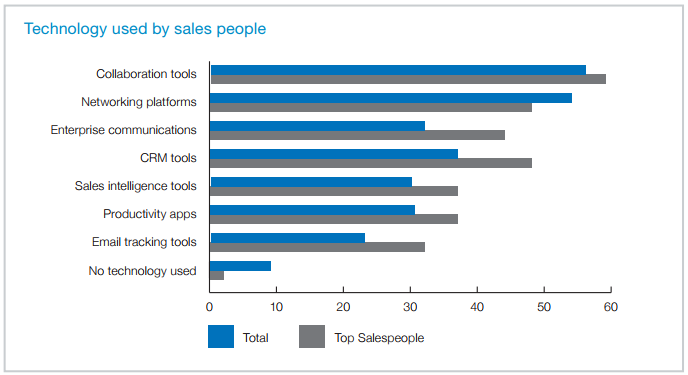Sales Tech Is Changing the Game for Sales Professionals
Last month, here at CMS-Connected, we asked if technology could solve the employee  engagement crisis and explained how it could. Well, it turned out technology does not only help with the employee engagement crisis, it also helps a sales professional establish trust, according to the second annual LinkedIn State of Sales, noting that 39 percent of buyers ranked trusting a sales rep as the single most important aspect of closing a deal, ahead of ROI on their purchase and price. Besides the finding suggesting that technology builds the crucial ingredient, trust, there are other key takeaways from the research that explain what drives increasing investment in sales technology and which channel is the most instrumental in helping top salespeople exceed their targets. The premise of this article is to expand on some other key findings organizations should keep in mind while developing a killer sales strategy.
engagement crisis and explained how it could. Well, it turned out technology does not only help with the employee engagement crisis, it also helps a sales professional establish trust, according to the second annual LinkedIn State of Sales, noting that 39 percent of buyers ranked trusting a sales rep as the single most important aspect of closing a deal, ahead of ROI on their purchase and price. Besides the finding suggesting that technology builds the crucial ingredient, trust, there are other key takeaways from the research that explain what drives increasing investment in sales technology and which channel is the most instrumental in helping top salespeople exceed their targets. The premise of this article is to expand on some other key findings organizations should keep in mind while developing a killer sales strategy.
According to the LinkedIn survey, more than 91% of sales professionals say that they are using such technologies to shorten lengthy sales cycles, close bigger deals and grow their revenue, while 90% of sales professionals report that sales technology is either “important” or “very important” for closing deals. Given Sales Force Automation Solutions used to be programmatically prescribing rigid sales processes wrapped around basic contact and account management, to get reports and such to address the needs of managers and executives, what has changed and have they become a sales force ally? Here’s what happened - due to evolving technology advancement and the altering needs of both salespeople and customers, the SFA vendors shifted their focus from a sales management tool to seller empowerment channel. As a result, today, sales teams are able to have unprecedented visibility into every aspect of the customer relationship, including support cases and back-office information such as contracts and inventory

Salespeople Using Social Media Outsell Their Peers
According to a Technavio research report, the global sales force automation market is expected to grow at an impressive CAGR of 9.8% over the next five years due to the increase in the need to reduce the sales cycle, while Gartner predicts that the market will reach $9.4 billion by 2019. When it comes to the most instrumental tool among the technology stack, LinkedIn suggests that strategically leveraging social networks continues to be a powerful tactic as it is resulting in meaningful impact and bridging buyer-seller gaps. The key word here is “strategically”, meaning that mining strangers’ personal feeds on Facebook for sales pitches is neither sales nor marketing activity, frankly, if anything, it is a public embarrassment.
From a strategy standpoint, Forrester surveyed 265 sales and marketing leaders for the study and found that “49 percent of B2B enterprises have developed a formal social selling program, and 28 percent are in the process of doing so.” After all, it is not rocket science but there are some dynamics that brands should be consistently aware of. At the end of the day, they need to find out the sweet spot between being a friend, trusted advisor, and business associate. In fact, the LinkedIn survey found that 64% of B2B decision makers said they wouldn’t engage with a salesperson if the communication was not personalized.
Incorporating social networks into a sales strategy is important not only for an explicit interaction with the right audience but also for gathering implicit data. Likes, comments, and shares on social networks hugely contribute to the analysis of the customer journey as they represent deep patterns related to consumer behaviors. All those interactions build up a relationship between a brand and a customer because, today, shopping experiences go well beyond a logical assessment of available alternatives, rather, they have become guided and emotional activities. Women, for instance, who comprise 63 percent of all online buyers, are now looking for an interactive relationship with brands in addition to convenience.
To put this into context, let’s remember Microsoft’s acquisition of LinkedIn for $26.2 billion, with an aim to integrate the most popular professional social network with its cloud-based product line, including Office 365 and Dynamics 365. Given that LinkedIn has passed 500 million registered users in 200 countries on its platform, Dynamics 365 is expected to dramatically increase the effectiveness of salespeople by tapping into their professional networks and relationships.
The study also demonstrates to us that sales professionals’ social media presence is as important as brands’ social media presence. In fact, 62% of millennials regularly look up sales professionals on social media, compared to 54% of Generation X and 31% of Baby Boomers. Additionally, 69% are more likely to speak with a sales professional that has a professional social media presence, compared to 58% of Generation X and 33% of Baby Boomers. How strong of a presence their sales professionals have on social media is also something that organizations should be very careful about when they are integrating social networks into their sales strategies.
Collaboration Tools are Popular
Another emerging trend among sales technologies is collaboration tools such as Box, Google Docs, Microsoft Office and Dropbox and according to the LinkedIn survey, they are now used by 59% of millennials, compared to 40% of Baby Boomers. Moreover, the study suggests that 39% of millennials are using enterprise communication tools such as Salesforce Chatter and Slack. In contrast, only 15% of Baby Boomers are using these tools to talk internally with colleagues.
In the past, collaborations tools, typically, were designed for sending messages. However, since Slack, a business-focused messaging platform provider, shook things up by evolving messaging apps beyond simple text communication tools to include commerce, file sharing, and artificial intelligence, the big players like Microsoft, Google, and Facebook has started heavily investing in adopting business social networking tools through either acquisitions or partnerships. Today, with the rise of technology and globalization, enterprises are on the lookout for technologies that can enable both their internal and external stakeholders to take part in the collaborative project co-creation or review of the internal business process in a secure manner by taking advantage of true modern cloud elasticity.
Close the Loop by Measuring Social Media Engagement
Technology is helping organizations not only to build interactions with prospects and customers but also to effectively measure how each interaction contributes to sales. Google, for instance, announced a new beta for Google Attribution which utilizes machine learning algorithms in order to dictate how much credit to assign to each interaction along the consumer journey. From there, it provides the analysis of an account's unique conversion patterns, comparing the paths of customers who convert to those who don’t. As a result, a marketer who receives this report can make an informed decision on bidding more on a channel that performs well or revoking budget from any marketing tactic that doesn’t lead to sales.
The technology related to social media engagement has come a long way. To capture the full potential of consumer data, more and more organizations, today, are utilizing social media sentiment that goes beyond typical social media metrics such as the numbers of clicks, mentions, retweets, shares and such as it is a great way to complement the information about how often your audience talks about your brand and understands the context behind those mentions. Also, it enables brands to avoid sharing any tone-deaf social media posts in an event of a large outcry in response to the product. For companies leveraging direct response channels such as retail, eCommerce, telecom, travel/hospitality, media/entertainment, and financial services, adopting sentimental analysis tools can give them an upper-hand in the market that they serve.
My POV
The bottom line is that it is critical to inject technology into every stage of the sales cycle as it is the most efficient and effective way of maximizing technology investment. That’s also the reason why all technology solution providers are heavily investing in their integration capabilities so their products could be seamlessly added to their customers’ digital ecosystems.
It is proven that social selling technologies help with building relationships have a major impact on their revenues. It is no secret that top-performing sales professionals are more likely to be frequent users of sales intelligence and social selling tools than their laggardly counterparts. More importantly, when we look over the horizon, this trend doesn’t seem to slow down, yet it is projected to continue growing over time and mostly because of tech-savvy millennials becoming increasingly dependent on tools. Now that they are becoming the wider pool of sales professionals, technology solution providers will continue to aim at helping them build and manage customer relationships through their social and collaboration tools.

Venus Tamturk
Venus is the Media Reporter for CMS-Connected, with one of her tasks to write thorough articles by creating the most up-to-date and engaging content using B2B digital marketing. She enjoys increasing brand equity and conversion through the strategic use of social media channels and integrated media marketing plans.